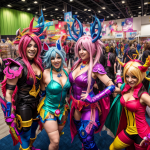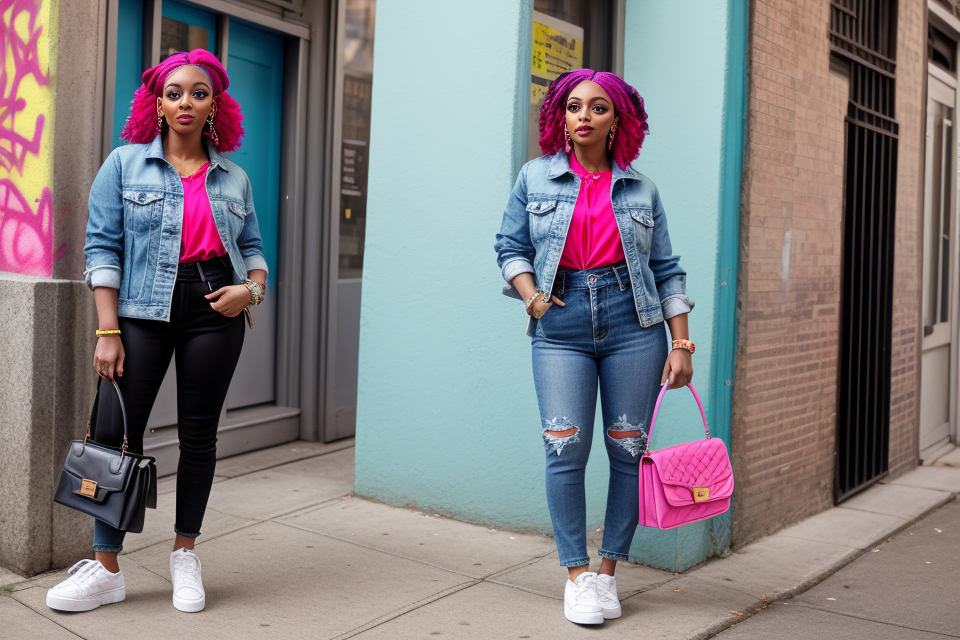Fashion is a constantly evolving world, and it seems like every other day there’s a new trend that everyone’s talking about. But what exactly is a fashion style? In its simplest form, a fashion style refers to the way a person dresses and presents themselves to the world. It’s a unique blend of colors, patterns, fabrics, and cuts that make up an individual’s personal style. It’s not just about looking good, but also about expressing oneself and showcasing one’s personality.
Fashion styles are influenced by various factors, including culture, time period, social media, and celebrities. From the classic and timeless look to the bold and daring, there’s a style for everyone. Whether you prefer vintage, bohemian, minimalist, or streetwear, your fashion style says a lot about who you are and what you stand for.
So, the next time you’re getting dressed, think about what you want to say to the world through your fashion choices. Whether it’s a bold statement or a subtle hint, your fashion style is your unique way of expressing yourself to the world.
A fashion style refers to a person’s unique way of expressing themselves through clothing, accessories, and overall appearance. It can be influenced by various factors such as culture, social status, personal preferences, and current trends. Fashion styles can be categorized into different genres, such as classic, bohemian, sporty, vintage, and more. A person’s fashion style can communicate their personality, values, and social identity, making it an important aspect of self-expression and social communication.
Understanding Fashion Styles
The Concept of Fashion Styles
- Definition of fashion styles
Fashion styles refer to the distinctive and unique manner in which a person dresses, presenting themselves to the world. This can include the clothing, accessories, and grooming choices that an individual makes, all of which contribute to their overall appearance.
- Evolution of fashion styles over time
Fashion styles have evolved significantly over time, with different eras and cultures influencing the way people dress. For example, the 1920s saw the rise of the flapper dress, while the 1960s were characterized by the use of bold, bright colors and the rise of the miniskirt.
- The role of fashion styles in society
Fashion styles play a significant role in society, reflecting and influencing cultural, social, and economic trends. They can also be used as a form of self-expression, allowing individuals to communicate their personal style and values to others.
Key Elements of Fashion Styles
When it comes to fashion, style is everything. It’s the way you put together your clothes, accessories, and overall look to express your personality and make a statement. But what exactly are the key elements of fashion styles?
- Colors: Colors play a crucial role in fashion. They can evoke different moods and emotions, and they can even change the way we perceive the same outfit. For example, a black dress can look sophisticated and elegant, while the same dress in bright pink can look playful and youthful.
- Textures: Textures add depth and dimension to an outfit. They can make an outfit look more interesting and dynamic, and they can even create the illusion of shape and volume. For example, a coat with a fur collar can make the wearer look more stylish and put-together.
- Patterns: Patterns are another key element of fashion styles. They can add visual interest to an outfit and create a sense of movement and energy. For example, a dress with a polka-dot print can look fresh and playful, while a dress with a stripe print can look sleek and chic.
- Materials: Materials are also an important factor in fashion styles. Different materials have different properties, such as weight, texture, and durability, which can affect how an outfit looks and feels. For example, a dress made of silk will drape differently than a dress made of denim, and it will also feel different to the touch.
- Accessories: Accessories are the final touch to any outfit. They can add interest and personality to an outfit, and they can even make or break an outfit. For example, a pair of statement earrings can add drama to a simple outfit, while a clunky necklace can detract from a chic outfit.
Overall, these key elements of fashion styles work together to create a cohesive look that reflects the wearer’s personality and style. By understanding these elements, you can start to develop your own unique fashion style and make a statement with your clothes and accessories.
Types of Fashion Styles
Streetwear
Streetwear is a fashion style that originated in the late 1980s and early 1990s, primarily in the United States and Japan. It emerged as a fusion of urban and sportswear, combining elements from both street and high-end fashion. Streetwear gained popularity among young people who sought to express their individuality and rebelliousness through their clothing choices.
Key Characteristics:
- Casual, comfortable clothing
- Sportswear-inspired designs, such as hoodies, sneakers, and baseball caps
- Oversized silhouettes and loose-fitting clothing
- Bold, graphic prints and logos
- A focus on high-quality materials and durable construction
Popular Streetwear Brands:
- Supreme
- Nike
- Off-White
- Palace
- Stussy
- A Bathing Ape (BAPE)
- Fear of God
- Vetements
- Hood by Air
- Kith
Streetwear has had a significant impact on the fashion industry, with many mainstream brands adopting its aesthetic and incorporating its key elements into their collections. However, the rise of streetwear has also been met with criticism, as some argue that it perpetuates a culture of conspicuous consumption and encourages a uniformity of style among young people.
Haute Couture
Haute couture is a type of fashion style that is characterized by its high-end, custom-made clothing. This style is typically associated with luxury and exclusivity, and is often created by high-end fashion designers.
- Origins and history
Haute couture has its roots in France, where it was first developed in the 19th century. It was originally created as a way for high-society women to have custom-made clothing that was both fashionable and high-quality. Over time, haute couture became associated with luxury and exclusivity, and it remains a highly sought-after fashion style today. - Key characteristics
One of the key characteristics of haute couture is the use of high-quality materials, such as silk, satin, and lace. These materials are often used in intricate and detailed designs, which are created by skilled craftsmen and seamstresses. Haute couture garments are also typically made to measure, ensuring a perfect fit for the wearer. - Popular haute couture designers
Some of the most popular haute couture designers include Chanel, Dior, and Versace. These designers are known for their high-end, custom-made clothing, and their designs are often seen on the red carpet and in high-end fashion magazines. Other popular haute couture designers include Armani, Givenchy, and Yves Saint Laurent.
Minimalism
Minimalism is a fashion style that emphasizes simplicity, elegance, and sophistication. It is characterized by a limited color palette, clean lines, and a focus on basic silhouettes. This style is often associated with modern and contemporary fashion, and it has had a significant impact on the fashion industry.
One of the key features of minimalism is its emphasis on simplicity. This means that clothing is designed to be basic and unadorned, with a focus on clean lines and simple shapes. This approach to fashion is often associated with modern and contemporary styles, and it is often characterized by a limited color palette.
Minimalism has had a significant impact on modern fashion. This style has been embraced by many designers and brands, who have incorporated its principles into their designs. Key designers and brands associated with minimalism include Jil Sander, Calvin Klein, and Muji. These designers and brands have helped to establish minimalism as a major force in contemporary fashion, and their influence can be seen in the work of many other designers and brands.
In conclusion, minimalism is a fashion style that emphasizes simplicity, elegance, and sophistication. It is characterized by a limited color palette, clean lines, and a focus on basic silhouettes. This style has had a significant impact on modern and contemporary fashion, and it continues to be a major force in the industry.
Bohemian
Bohemian fashion style is a unique and eclectic form of self-expression that emerged in the 1960s and 1970s as a countercultural movement. The bohemian style is characterized by a mix of vintage, ethnic, and bohemian-inspired clothing, often featuring bright colors, bold patterns, and flowing silhouettes.
Definition and Characteristics
The bohemian style is defined by its carefree and free-spirited approach to fashion. It emphasizes individuality, creativity, and self-expression, often incorporating vintage, ethnic, and bohemian-inspired clothing. Key characteristics of the bohemian style include:
- A mix of vintage, ethnic, and bohemian-inspired clothing
- Bright colors
- Bold patterns
- Flowing silhouettes
- Natural fabrics
- Layers
History and Influences
The bohemian style emerged in the 1960s and 1970s as a countercultural movement, influenced by the hippie movement and the desire for social change. It was characterized by a rejection of mainstream fashion and an embrace of individuality and self-expression. The bohemian style was influenced by various cultures, including the Indian and Eastern European cultures, and was often associated with the counterculture movement.
Key Designers and Brands
The bohemian style is often associated with a mix of high-end and bohemian-inspired brands, including:
- Celine
- Chloe
- Saint Laurent
- Alexander McQueen
- Free People
- Urban Outfitters
- Anthropologie
The bohemian style continues to be a popular fashion trend, with designers and brands incorporating its carefree and free-spirited approach to fashion into their collections.
Vintage
Vintage fashion is a style that is inspired by clothing and trends from a specific era in history. This type of fashion style is characterized by its unique and often retro aesthetic, which is often associated with a particular decade or era.
Vintage fashion is defined by its attention to detail, quality craftsmanship, and unique style. This type of fashion is often associated with a particular era, and is characterized by its distinctive aesthetic, which includes specific silhouettes, fabrics, and styles.
Vintage fashion has its roots in the past, and is often influenced by the fashion and culture of a particular era. This type of fashion style is often associated with a specific decade or era, and is characterized by its unique aesthetic, which reflects the fashion and culture of that time period.
There are many key designers and brands that are associated with vintage fashion, including Coco Chanel, Christian Dior, and Vivienne Westwood. These designers and brands are known for their unique and iconic styles, which have helped to shape the vintage fashion industry.
Fashion Styles and Personal Expression
The Importance of Fashion Styles in Personal Expression
- Communicating identity and values
Fashion styles play a significant role in communicating one’s identity and values. Through the clothes we wear, we can express our beliefs, interests, and personalities to others. For example, someone who values sustainability may choose to wear clothing made from organic materials or recycled fabrics, while someone who is into streetwear may prefer brands that are associated with urban culture. - Self-expression through clothing
Fashion styles also serve as a means of self-expression. Clothing can be a form of creative expression, allowing individuals to showcase their unique style and personality. People can experiment with different styles, colors, and patterns to create a look that reflects their individuality. Moreover, fashion styles can be used to express moods, emotions, and even political views. - The impact of fashion styles on self-esteem
Finally, fashion styles can have a significant impact on self-esteem. When we feel confident and comfortable in what we wear, we tend to feel more confident and comfortable in our own skin. Wearing clothes that we feel good about can boost our self-esteem and help us feel more empowered. On the other hand, wearing clothes that don’t fit or feel uncomfortable can have the opposite effect, causing us to feel self-conscious and unsure of ourselves.
Fashion Styles and Social Media
The role of social media in fashion trends
- Social media platforms, such as Instagram and TikTok, have become powerful tools for disseminating fashion trends and ideas.
- These platforms allow individuals to share their personal style and influence others, creating a virtual community of fashion enthusiasts.
- Social media has also democratized the fashion industry, giving smaller designers and brands a platform to showcase their work and reach a wider audience.
How social media influences personal style
- Social media provides individuals with a wealth of information and inspiration when it comes to fashion.
- Users can browse through countless images and videos to discover new trends, styles, and brands.
- Social media has also made it easier for individuals to express their personal style, as they can draw inspiration from a wide range of sources and share their own looks with others.
The impact of influencers on fashion styles
- Influencers, or individuals with a large following on social media, have a significant impact on fashion trends and styles.
- They have the power to shape public opinion and influence what is considered fashionable or on-trend.
- Influencers also have the ability to promote specific brands and products, further impacting the fashion industry and personal style choices.
Overall, social media has greatly impacted the way individuals express their personal style and has become a key factor in shaping fashion trends.
Fashion Styles and Cultural Identity
The Relationship between Fashion and Culture
Fashion and culture are intertwined, with each influencing the other in a constant cycle. Fashion reflects cultural values, attitudes, and beliefs, while also shaping the way people perceive and express their cultural identity. Clothing, accessories, and hairstyles can all convey cultural affiliations, whether it’s through traditional ethnic dress or contemporary fashion trends that are popular within a particular culture.
How Cultural Identity Influences Fashion Styles
Cultural identity plays a significant role in shaping an individual’s fashion choices. Factors such as geography, history, religion, and social norms can all contribute to the development of unique fashion styles within a particular culture. For example, traditional African textiles and patterns can be seen in modern fashion, representing a connection to one’s cultural heritage.
Moreover, cultural identity can also influence fashion choices through the adoption of specific colors, fabrics, and materials. For instance, the use of silk and brocade in traditional Chinese clothing signifies wealth and status, while denim and leather are often associated with American culture.
Examples of Cultural Fashion Styles
Numerous cultural fashion styles have emerged throughout history, reflecting the diverse influences and traditions of different cultures. Some examples include:
- Traditional Japanese Kimono: The kimono is a traditional garment that has been worn in Japan for centuries. It is typically made of silk or cotton, and features intricate designs and patterns that reflect Japanese art and culture.
- Saris from India: Saris are a traditional garment worn by women in India, consisting of a drape of fabric that covers the body. They are often made of colorful fabrics such as silk, chiffon, or georgette, and feature intricate embroidery, beading, and sequins.
- Paisley Shawls from Kashmir: Paisley shawls are a traditional item of clothing in Kashmir, a region in northern India. They are made of fine wool and feature intricate designs of paisley patterns, which are said to represent the union of two lovers.
- Tribal Beadwork from Africa: Tribal beadwork is a traditional craft practiced by various tribes in Africa. It involves the use of beads, thread, and needles to create intricate patterns and designs on clothing and accessories.
- Western Cowboy Boots: Cowboy boots are a traditional type of footwear worn in the western United States and Mexico. They are typically made of leather, have a distinctive shape, and are often adorned with intricate designs and patterns.
These examples illustrate how cultural identity can shape fashion styles, leading to the development of unique and distinctive clothing and accessories that reflect the traditions and values of different cultures.
The Future of Fashion Styles
Emerging Trends in Fashion Styles
As the fashion industry continues to evolve, new trends and styles emerge, reflecting the changing attitudes and values of society. Here are some of the emerging trends in fashion styles:
Sustainable fashion
Sustainable fashion is a growing trend that focuses on creating clothing and accessories with minimal environmental impact. This includes using eco-friendly materials, reducing waste, and promoting ethical labor practices. Sustainable fashion brands are gaining popularity as consumers become more conscious of the environmental impact of their purchases.
Inclusivity and diversity in fashion
Inclusivity and diversity in fashion are becoming increasingly important as society becomes more diverse. Brands are beginning to recognize the need for clothing that caters to a wider range of body types, ages, and ethnicities. This includes offering a wider range of sizes, creating adaptive clothing for people with disabilities, and featuring models of diverse backgrounds in advertising campaigns.
Technology and fashion
Technology is playing an increasingly important role in the fashion industry, from virtual reality shopping experiences to smart clothing that can monitor the wearer’s health. Wearable technology, such as smartwatches and fitness trackers, is becoming more fashionable and practical, integrating functionality into stylish designs. Additionally, 3D printing technology is allowing designers to create unique and customized pieces, opening up new possibilities for fashion design.
The Impact of Fashion Styles on Society
- The role of fashion in social change
- Fashion has long been a powerful tool for social change, allowing individuals to express their beliefs and values through their clothing choices. From the 1960s civil rights movement to the modern-day Black Lives Matter movement, fashion has played a significant role in shaping social and political discourse.
- Fashion designers and brands have also used their platforms to raise awareness about important social issues, such as climate change, gender equality, and racial justice. For example, in 2019, the fashion industry was responsible for 9% of global carbon emissions, and many designers have since taken steps to reduce their environmental impact.
- The future of fashion and its impact on society
- As the world becomes increasingly interconnected and globalized, the impact of fashion on society is only set to grow. The rise of fast fashion and online shopping has led to an increase in consumption and waste, with many consumers purchasing cheap, disposable clothing that is often made from unsustainable materials.
- However, there is a growing movement towards more conscious consumption, with consumers becoming more aware of the environmental and social impact of their purchases. This shift towards sustainability and ethical production will likely shape the future of fashion, with designers and brands competing to create more eco-friendly and socially responsible products.
- The importance of conscious consumption in fashion
- Conscious consumption refers to the practice of making mindful and informed decisions about what we buy and how we use it. In the context of fashion, this means choosing clothing made from sustainable materials, supporting ethical and fair trade production, and avoiding fast fashion and overconsumption.
- By adopting a more conscious approach to fashion, consumers can help to reduce the negative impact of the industry on the environment and society. This includes reducing waste, supporting local and small-scale producers, and advocating for more sustainable and ethical practices within the industry.
- As more consumers become aware of the importance of conscious consumption, the fashion industry will be forced to adapt and evolve to meet these changing demands. This could include the development of new technologies and materials, the adoption of more sustainable production methods, and the creation of more transparent and accountable supply chains.
FAQs
1. What is a fashion style?
A fashion style refers to a particular manner of dressing or grooming that is adopted by an individual or a group of people. It can be defined as a person’s unique way of expressing themselves through their clothing, accessories, and overall appearance. Fashion styles can be influenced by various factors such as culture, society, history, and personal preferences.
2. How does one develop their own fashion style?
Developing a personal fashion style involves experimenting with different clothing items, fabrics, colors, and accessories. It is important to consider one’s body shape, skin tone, and personal preferences when selecting clothes. Additionally, paying attention to current fashion trends and incorporating them into one’s wardrobe can help in developing a unique style.
3. What are the different types of fashion styles?
There are various types of fashion styles, including but not limited to:
- Classic
- Bohemian
- Minimalist
- Streetwear
- Elegant
- Grunge
- Sportswear
- Avant-garde
Each style is characterized by its own set of fashion rules and guidelines.
4. How often should one update their fashion style?
There is no set rule for updating one’s fashion style. Some people prefer to stick to a classic, timeless look, while others like to keep up with the latest trends. Ultimately, it depends on personal preferences and lifestyle. However, incorporating new pieces into one’s wardrobe every season can help keep the look fresh and up-to-date.
5. Is there a right or wrong way to dress?
There is no right or wrong way to dress, as fashion is a form of self-expression. However, it is important to dress appropriately for different occasions and to be mindful of cultural and social norms. What may be considered fashionable in one culture or society may not be acceptable in another, so it is important to be aware of these differences.









